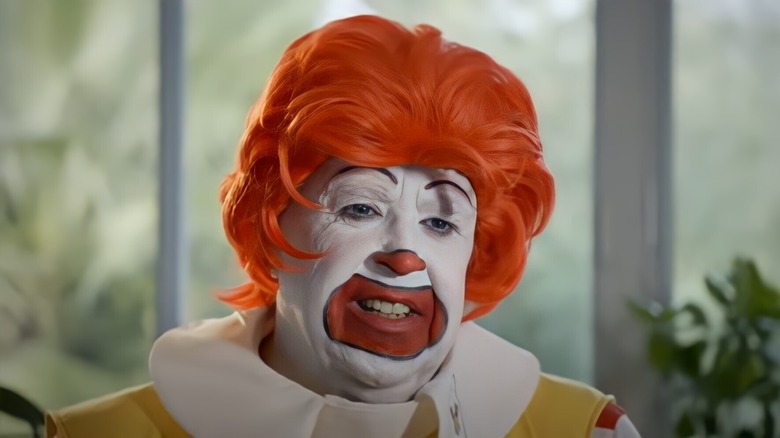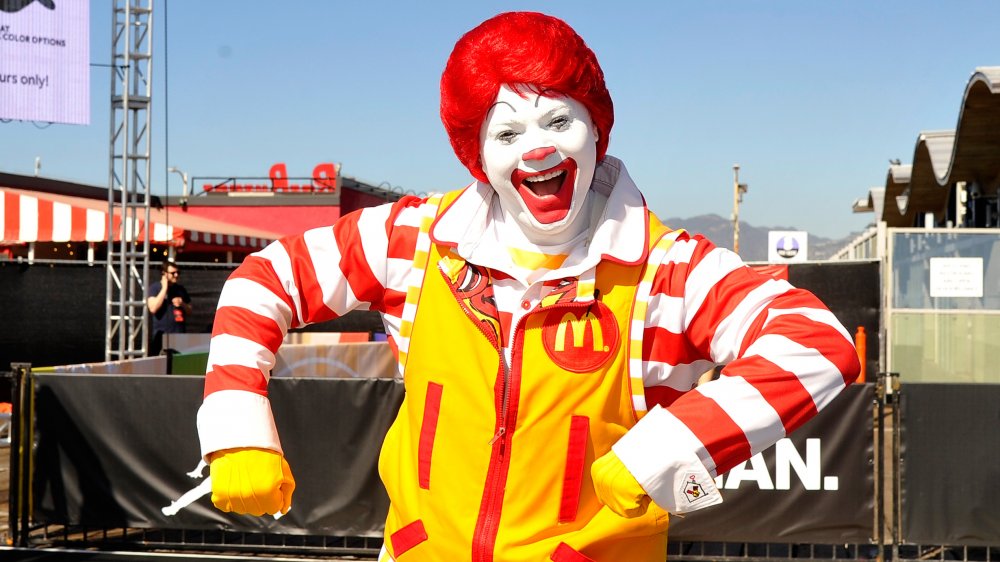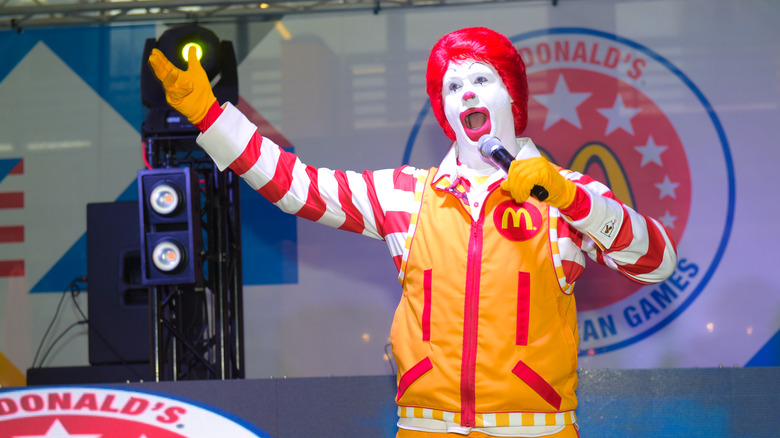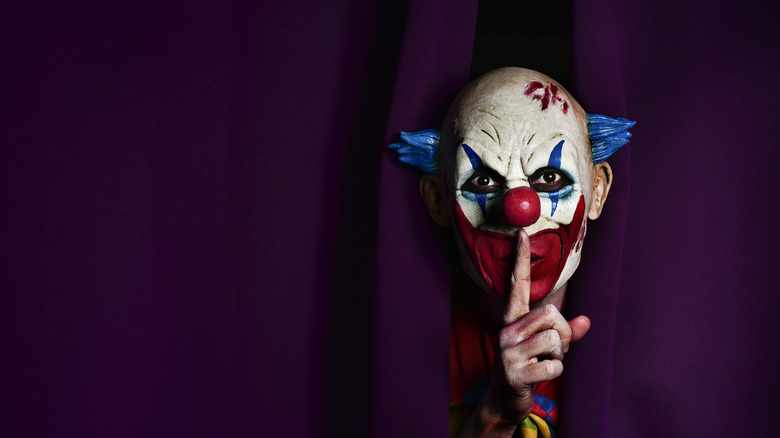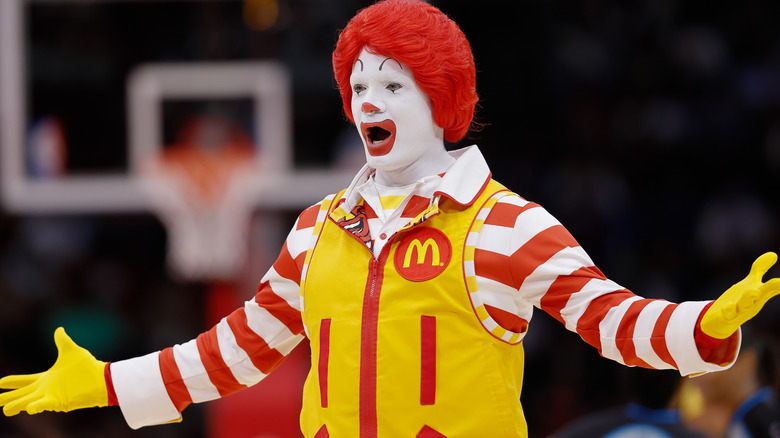The Real Reason McDonald's Got Rid Of Ronald McDonald
If you're a fan of both vintage commercials and meat-themed nightmares, then you know that the Ronald McDonald of old seemed exceedingly more likely to make other people disappear than to disappear himself. His commercial debut in 1963 introduces him in a dark room, sitting with his head turned away. Suddenly a clown with a cup for a nose and a food tray for a hat pops out of the disappearing darkness like a Jack the Ripper-in-the-box. As part of his pitch, he creepily informs viewers that he "[likes] to do everything boys and girls like to do."
A 1963 commercial goes in a more horrifying direction as a rollerskating Ronald magically wills burgers into existence and uses them to bribe a small boy into dismissing his mom's warnings not to talk to strangers. It ends with them leaving together. Alone. From there, Ronald probably reveals his true form — a giant spider — and gleefully eats the trusting child like a Mac Jr. burger. If McDonald's was looking for a clown mascot that was both enduring and endearing, this clearly wasn't it. Or at least he was the wrong kind of "It."
Ronald McMurderface was eventually replaced by the happy, red-haired Ronald who dressed like sunshine and befriended a giant purple gumdrop named Grimace. However, after years of looking wholesome and hopefully not devouring children around the world, he seemingly vanished from advertising materials.
McDonaldland
As part of an advertising campaign targeted at children, McDonald's created McDonaldland, a fantasy world used in the company's commercials from 1971 to 2003. It centered on the adventures of Ronald McDonald and his friends, including Grimace, Hamburglar, Birdy the Early Bird, Sundae, Mayor McCheese, Captain Crook, Officer Big Mac, and the Professor. These characters became staples of the company's advertising and marketing strategy — they were notably used in PlayPlace artwork and Happy Meal toys. But though the fast food chain aggressively targeted kids in the '60s and '70s, it eventually shifted its marketing strategy to be more inclusive of all kinds of customers.
According to slow start, McDonald's began to shift its advertising approach with the "I'm Lovin' It" campaign in 2003." The YouTube channel said the campaign was the "push for modernization that would slowly but surely phase out the child-friendly aspect of their restaurants and a "drastically new approach that placed emphasis on people and the customer's own individual preference."
Of course, the characters didn't disappear completely. As FOX noted, in 2022, McDonald's revived McDonaldland characters Grimace, the Hamburglar, and Birdie the Early Bird for adult Happy Meal toys — but Ronald McDonald was conspicuously absent.
Ronald McGone-ald
In addition to the shift in marketing toward adults, the dial-back of Ronald McDonald might also have to do with the company's attempt to distance itself from its "unhealthy" reputation. A 2004 article in the Journal of the Royal Society of Medicine observed that "all of the children in China recognize the image of Ronald McDonald, even though they might not be able to read English." That sounds like a win for the clown's fast-food overlord until you consider that the article was about obesity and linked McDonald's famous corporate mascot with the fat-ification of the country. Fast-forward to 2011, and Time Magazine runs a headline asking, "Where's Ronald?"
Was this wholesome-looking mascot secretly eating obese children the whole time, causing him to kick the bucket with his preposterously large clown shoes? Not to anyone's knowledge. Rather, as Time explained at the time, McDonald's wanted to veer in a different advertising direction because Ronald had become synonymous with fattening fast food. So he had to take a "backseat to upscale marketing."
The company faced criticism for marketing clowns to children
For years, McDonald's faced criticism for using clowns to market fast food to children. Notably, in 2011, 500 doctors and healthcare professionals wrote an open letter condemning the company for its use of Ronald McDonald and published it in U.S. newspapers. "Stop making the next generation sick — retire Ronald and the rest of your junk food marketing to kids," it read.
Then-McDonald's CE Jim Skinner pushed back against the criticism and told shareholders that he believes in the "democratic process" and pointed to the "right to choose" in American society, per The Seattle Times. Skinner pointed to Ronald McDonald's involvement in charities and denied that the mascot advertised "unhealthy food to children." "We provide many choices that fit with the balanced, active lifestyle," he said. "It is up to them to choose and their parents to choose, and it is their responsibility to do so." Still, the criticism has continued throughout the years.
McDonald's has had a relationship with children's hospitals since 1977, and some have cast a darker light on the business partnership. In a 2015 The San Diego Union-Tribune piece, physician Devesh Madhav Vashishtha called out the "insidious" nature of the Ronald McDonald House facilities, which offer free lodging for sick children and appeal to lower-income families. "It is precisely children of these families who are most at risk for developing obesity, hypertension and type 2 diabetes," he wrote.
The scary clowns
Marketing criticism aside, in 2016, CNBC reported that Ronald McDonald had taken another hiatus because of a spate of scary clown sightings popping up everywhere. That year, pranksters dressed as clowns terrorized people — sometimes with weapons — across communities in the United States. Before long, the trend spread to the United Kingdom, where one even chased children with a knife on their way to school.
"McDonald's and franchisees in the local markets are mindful of the current climate around clown sightings in communities and as such are being thoughtful in respect to Ronald McDonald's participation in community events for the time being," a spokeswoman for McDonald's told CNBC. The company did not provide any information on how many events Ronald was regularly involved in at the time and how they would change.
But after this statement, the company suggested that — scary clowns aside — the mascot's public schedule had not shifted over the years. "Nothing has changed in regards to his public appearances over recent years except for his actual appearance," spokeswoman Terri Hickey said in a statement, per the Orlando Sentinel.
Where is he now?
As of this writing, Ronald McDonald still makes appearances at public events like the annual Thanksgiving Day Parade in New York and company events like basketball games. Above he is seen at the 2023 McDonald's All-American Boys Game at Toyota Center in Houston, Texas. He is also still the name of the Ronald McDonald House Charities, which says its programs are a "home away from home that provide comfort, support and resources to families who travel far from home for the medical care their child needs."
The last post on the official Ronald McDonald Instagram account was in July 2021. "Can't wait to get out of the house and see you all at events and restaurants in the future!" the captain reads. The video shows the clown packing his outfit for a "road trip." The account appears to have been actively posting since 2014 before stopping in 2021.
